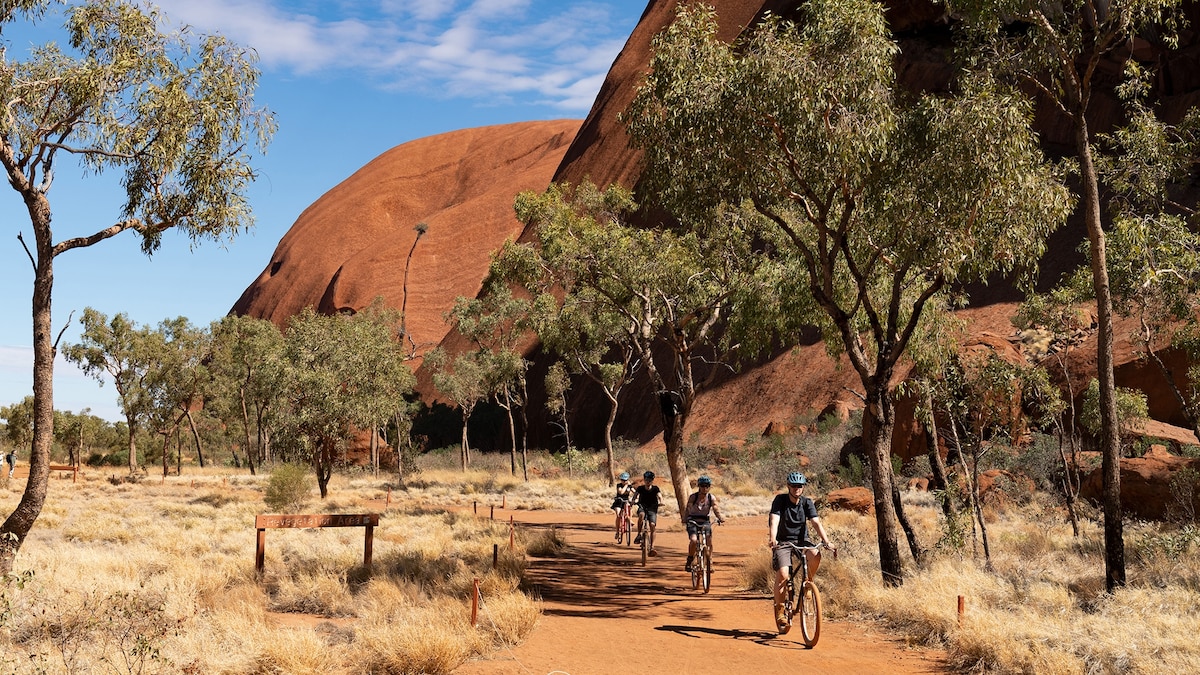Copyright National Geographic

Uluru and Kata Tjuta were formed over 500 million years ago, and these living landscapes have been sacred to the Indigenous people for tens of thousands of years. Uluru is one of the world’s largest monoliths, and each mark, watering hole, and cave tells an ancient story. Neighboring Kata Tjuta’s domes inspire its name, which means “many heads” in the local Pitjantjatjara language. Both of their ochre-colored shapes glow at dusk and dawn, transforming the landscape around them. This land is the home of the Anangu people, the local Indigenous groups. Indigenous Australians are the oldest living culture in the world, and Uluru-Kata Tjuta National Park is a place where their culture thrives in a beautiful landscape full of art centers and traditional storytelling. October 2025 marks the 50-year anniversary of “Handback”, when the government returned the title deeds for Uluru-Kata Tjuta National Park to the Anangu Traditional Owners. Since then, the Anangu people have transformed this area by instating environmental protections, renaming sacred sites, and honoring tradition. They welcome visitors to learn about their way of life with immersive, authentic experiences. One of the newest ways to explore the region is the five-day trek that was developed in consultation with the Anangu Traditional Owners. For the first time, travelers will be able to spend the night in Uluru-Kata Tjuta National Park with ancestral stories, native foods, and eco-conscious lodging. The Anangu people’s home is their pride and joy, and their stories show travelers that there is magic all around Uluru-Kata Tjuta National Park. (See all 25 destinations that made our list of the best places to visit in 2026.) What to do Art and storytelling has always been significant in Indigenous communities, including the Anangu. Stories tell their history, honor their ancestors, and teach important lessons. Travelers can meaningfully follow the evolution of Indigenous storytelling at Uluru-Kata Tjuta National Park. Visitors can see the ancient cave paintings on Uluru’s faces during a base walk, or Segway experience. Also, explore Kata Tjuta with the Walpa Gorge walk or take in the golden hour at the dune viewing area. Travelers can then learn from local artists at the Uluru-Kata Tjuta Cultural Center’s dot painting workshops. Visits to the Gallery of Central Australia also ethically support art centers from around the region. The colors of the desert have also inspired international artists like Bruce Monro, and it was the original inspiration for his global phenomenon, Field of Lights. The 50,000 solar-powered spindles of light symbolize the desert bloom after a storm, and it was revamped in 2025 by Bruce Munro’s team. When to go The best time to visit is between May and September, when the maximum temperature is between 70 and 80 degrees Fahrenheit. The pleasant weather makes it easier to do activities during the day, though the temperatures drop sharply after the sun sets. October through March, spring and summer in Australia, can get extremely hot and stormy. This is the rainy season for Central Australia, and the temperature during the day is often above 100 degrees Fahrenheit. The rain can enhance the experience in many ways, with rare waterfalls that flow down Uluru during storms. Where to eat Experience Indigenous ingredients at Sounds of Silence, a dinner that overlooks Uluru-Kata Tjuta National Park and provides entry to the Field of Lights. This includes outback style canapes, a three-course buffet, and a selection of Australian wine and beer. The menu changes with the season, frequently highlighting local ingredients such as crocodile, barramundi, and kangaroo. Travelers can partake in a similar dinner before going to Wintjiri Wiru. Before the light show, they serve canapes and drinks in the open-air desert theater. This is followed by a personal picnic basket filled with local ingredients like smoked emu, acacia tree seeds, and green ants. During the dry heat of the day, enjoy a casual lunch at Pira Pool Bar at the five-star Sails in the Desert resort. Nibble on fresh salads and classic burgers between dips in the water, or enjoy a craft cocktail while tanning on a lounge chair. In town, eat some meat pies, sandwiches, and classic pastries at Kulata Academy Cafe, an easygoing spot that supports trainees at the National Indigenous Training Academy (NITA). NITA gives young Indigenous Australians the chance to explore Australia while gaining valuable skills for future employment. Where to stay Sails in the Desert: This five-star property is the perfect place to cool off and relax after a long day of exploring in Uluru. The modern style of the resort contrasts the ancient history of the region, with multiple restaurants, a refreshing swimming pool, and a gorgeous spa. Emu Walk Apartments: This apartment-style lodging is ideal for families or big groups. Spacious rooms come with living areas, kitchens, and laundry machines. Getting around Visitors can fly into Ayers Rock/Connellan Airport (AYQ). This is just a short drive from the park and town, and one can see Uluru through the plane windows. Travelers can often get around popular sites without a car, especially because there are shuttles and most guided tours include hotel pickups. Those who wish to explore more of the Red Centre, including Kings Canyon and Alice Springs, can book tours with private drivers through companies like Autopia.



